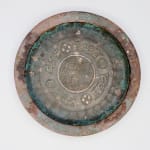Seljuk Bowl, depicting the Buraq, Twelfth Century AD
Bronze
2.5 x 18.4 cm
1 x 7 1/4 in
1 x 7 1/4 in
CC.29
Further images
-
(View a larger image of thumbnail 1
)

-
(View a larger image of thumbnail 2
)

-
(View a larger image of thumbnail 3
)

-
(View a larger image of thumbnail 4
)

-
(View a larger image of thumbnail 5
)

-
(View a larger image of thumbnail 6
)

-
(View a larger image of thumbnail 7
)

-
(View a larger image of thumbnail 8
)

-
(View a larger image of thumbnail 9
)

-
(View a larger image of thumbnail 10
)

-
(View a larger image of thumbnail 11
)

This beautiful Seljuk bowl has vertical sides and a flat bottom. In the centre is a the motif of al-buraq, the winged creature that was said to have transported the...
This beautiful Seljuk bowl has vertical sides and a flat bottom. In the centre is a the motif of al-buraq, the winged creature that was said to have transported the prophet Muhammed on his night journey to seventh heaven, known as the mi’raj, where he met with the prophets of the Muslim faith, and later spoke to Allah. The figure is in a form similar to a Greek sphinx, with a human head, an equine body, wings, and a serpentine tail. The figure sits in a highly decorative roundel, full of incised designs. Around the roundel are two rosettes and two further roundels, between which are calligraphic designs. This pattern is repeated on the rim, except with six rather than four elements. The underside has another roundel depicting al-buraq. The rim is somewhat damaged by oxidation, and the overall piece has a green patina.
The Seljuks were a high mediaeval Turco-Persian people who, at their height in the AD 1090s, dominated an area from the Levantine coast to Afghanistan and India. The Empire was founded in AD 1034 by Tughril, who ruled alongside his brother Chaghri and uncle Musa Yabghu. But the time of the Seljuks was to be brief; by the Twelfth Century AD, the Empire was in decline, and was supplanted by the Khwarazmian Empire in AD 1194. This brief period of dominance, however, accompanied an artistic flourishing, especially in metalwork and in a form of pottery known as mina’i-bowls.
This bowl demonstrates the Seljuk tendency to reject their Turkic roots in favour of Persian models, both in art and language, over the course of the Twelfth Century AD. The bowl also stands as testament to the imagination and skill of Seljuk metalworkers; under the Seljuks, bronze-casting flourished, and workshops were set up in and around the region of Khorasan. This carefully incised bowl shows the skill and sensitivity of the craftsman in picking out the delicate forms of the calligraphy and the design.
The Seljuks were a high mediaeval Turco-Persian people who, at their height in the AD 1090s, dominated an area from the Levantine coast to Afghanistan and India. The Empire was founded in AD 1034 by Tughril, who ruled alongside his brother Chaghri and uncle Musa Yabghu. But the time of the Seljuks was to be brief; by the Twelfth Century AD, the Empire was in decline, and was supplanted by the Khwarazmian Empire in AD 1194. This brief period of dominance, however, accompanied an artistic flourishing, especially in metalwork and in a form of pottery known as mina’i-bowls.
This bowl demonstrates the Seljuk tendency to reject their Turkic roots in favour of Persian models, both in art and language, over the course of the Twelfth Century AD. The bowl also stands as testament to the imagination and skill of Seljuk metalworkers; under the Seljuks, bronze-casting flourished, and workshops were set up in and around the region of Khorasan. This carefully incised bowl shows the skill and sensitivity of the craftsman in picking out the delicate forms of the calligraphy and the design.










